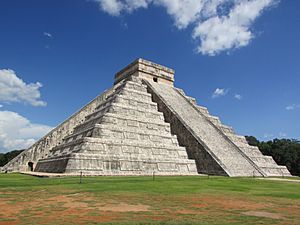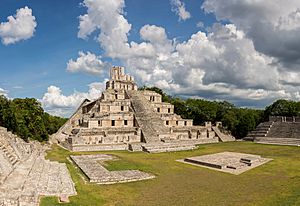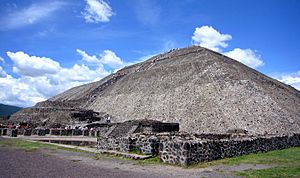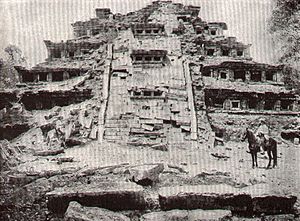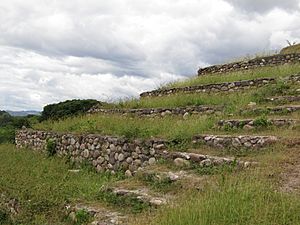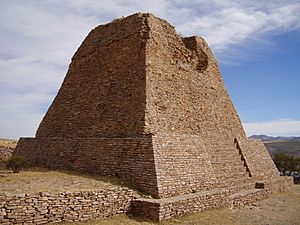Mesoamerican pyramids facts for kids
Mesoamerican pyramids are amazing ancient buildings found in places like Mexico and Central America. They are a big part of the history and architecture of ancient civilizations there.
While they might look a bit like the pyramids in Egypt, Mesoamerican pyramids are different. They usually have flat tops, and many have temples built right on top. They also have stairs going up their sides, which people used to climb to the top.
The biggest pyramid in the world, by how much space it takes up, is the Great Pyramid of Cholula in Mexico. Builders of these pyramids often decorated them with incredible stories. These stories were about important figures like the Maya Hero Twins or the feathered serpent god Quetzalcoatl. They also showed myths about how the world was created and important ceremonies. These stories were carved as hieroglyphs on the steps, walls, and sculptures.
Contents
- Aztec Pyramids: Builders of Central Mexico
- Maya Pyramids: Ancient Wonders of the South
- Olmecs: Early Builders of Mesoamerica
- Purépechans: Unique "T"-Shaped Pyramids
- Teotihuacan: A Powerful Ancient City
- Toltec: Masters of Tula
- Classic Veracruz: Intricate Designs
- Zapotecs: Early Innovators of Oaxaca
- Lencans: Pyramids in Honduras
- Other Notable Sites
- The Debate Over Olmec Influence
- See also
Aztec Pyramids: Builders of Central Mexico

The Aztecs were a powerful civilization in central Mexico from the 1300s to the 1500s. Their main city was Tenochtitlan, which is where Mexico City is today. The Aztecs learned a lot from older cultures in the area, like the people of Teotihuacán. They used and changed some of their building styles.
Some famous Aztec pyramid sites include:
Maya Pyramids: Ancient Wonders of the South
The Maya people lived in southern Mexico and parts of Central America, like Guatemala, Belize, and Honduras. About 3,000 years ago, they started building ceremonial structures with pyramids and plazas.
At first, these were simple burial mounds. But over time, they became the amazing stepped pyramids we see today. Maya pyramids were often made with carefully carved stones, creating their unique stair-stepped look. Many had a flat platform at the top with a smaller temple dedicated to a Maya god.
Maya pyramids were also used as burial places for important rulers. These structures come in many shapes and sizes, depending on the region and time period they were built.
- Aguateca
- Altun Ha
- Bonampak
- Calakmul
- Caracol
- Chichen Itza
- Cholula
- Coba
- Comalcalco
- Copan
- Dos Pilas
- Edzna
- El Mirador
- El Tigre
- La Danta
- Kaminaljuyu
- Lamanai
- Los Monos
- Lubaantun
- Mayapan
- Mixco Viejo
- Moral Reforma
- Nim Li Punit
- Palenque: Temple of the Inscriptions
- San Andrés, El Salvador
- Tazumal
- Tikal: Tikal Temple I; Tikal Temple II; Tikal Temple III; Tikal Temple IV; Tikal Temple V; Lost World Pyramid; Talud-Tablero Temple
- Tonina
- Uxmal
- Yaxchilan
- Yaxha
- Xunantunich
Olmecs: Early Builders of Mesoamerica
The Olmecs were an ancient group of people who lived in Mesoamerica from about 1300 to 400 BCE. Their territory stretched from Veracruz to Tabasco.
The Olmec Great Pyramid of La Venta is thought to be one of the earliest and most complex ceremonial sites in Mesoamerica.
Purépechans: Unique "T"-Shaped Pyramids
The Tarascan state was an ancient culture in what is now the Mexican state of Michoacán. Today, the Purépecha people still live there. Purépechan buildings are known for their special "T"-shaped step pyramids called yácatas.
- Tzintzuntzan
Teotihuacan: A Powerful Ancient City
The Teotihuacan civilization was very powerful from about 300 BCE to 500 CE. At its peak, it covered most of Mesoamerica. The Teotihuacan culture declined around 550 CE. After that, other large city-states grew, like Xochicalco and Cholula.
Important pyramid sites from this culture include:
- El Castillo and High Priest's Temple in Chichen Itza
- Pyramids of the Sun, the Moon, and Temple of the Feathered Serpent in Teotihuacan
- Xochicalco
- Talud-tablero (a special building style)
Toltec: Masters of Tula
The ancient city of Tula was the capital of the Toltec empire. It has some of the best-preserved five-tiered pyramids in Mesoamerica. The site has two main pyramids, Pyramid B and Pyramid C.
The Toltec empire lasted from about 700 to 1100 CE. The city of Tula, about 70 km (40 miles) northwest of modern Mexico City, was a thriving city with about 40,000 people. The main plaza in Tula had two pyramids and a ritual ball court.
Pyramid B, also known as the Pyramid of Quetzalcoatl, is a five-tiered pyramid with four giant carved pillars on top. It was named after a legendary priest, also called Quetzalcoatl. He was said to have stopped wars between Mayan cities. After that, the Toltecs began to worship Quetzalcoatl.
Classic Veracruz: Intricate Designs
The most famous pyramid from the Classic Veracruz culture is the Pyramid of Niches in El Tajín. It is smaller than pyramids from other cultures but has very detailed and intricate designs.
Zapotecs: Early Innovators of Oaxaca
The Zapotecs were one of the earliest Mesoamerican cultures. They were powerful in the Valley of Oaxaca region from about 1000 BCE to the 1300s CE.
- Monte Albán
- Mitla
Lencans: Pyramids in Honduras
Historians divide the Lenca people's history into two periods: the early Proto-Lencas and the later Lencas we know today.
Some Lencan pyramid sites include:
Other Notable Sites
These sites are from northern Mesoamerica. The cultures that built them are not fully known.
Altavista: An Astronomical Center
This site was an important center for astronomy and ceremonies. It was built by the Chalchihuite culture and was active for about 800 years (around 200 to 1000 CE). Altavista is known for its very accurate buildings. The most famous parts are: The Moon Plaza, The Votive Pyramid, the Ladder of Gamio, and The Labyrinth. In The Labyrinth, you can see the equinoxes and seasons very precisely.
La Quemada: A Hilltop Fortress
Many buildings at La Quemada were built on artificial terraces on the side of a hill. They used stone slabs and clay for construction. Key structures include: The Hall of Columns, The Ball Court, The Votive Pyramid, The Palace, and the Barracks. At the highest point of the hill is The Fortress. It has a small pyramid and a platform, surrounded by a wall over 800 meters long and up to six feet high. La Quemada was used from 800 to 1200 CE. The people who built and lived there are not known for sure, but they might have been from the Chalchihuites or Malpaso cultures.
The Debate Over Olmec Influence
Experts have been discussing how much the Olmecs influenced the architecture of other Mesoamerican pyramids.
Mother vs. Sister Culture Ideas
The idea of a "mother culture" in Mesoamerica started in 1942. It suggested that the Olmecs were the main culture from which other Mesoamerican societies got most of their ideas and ways of life.
The "sister culture" idea argues that the Olmecs were not the only source of cultural influence. Instead, they were one part of a bigger exchange of ideas happening across Mesoamerica. This debate has also led to ideas about "costly signaling." This means cultures might have been influenced by impressive displays, like grand architecture. Another part of the debate questions if calling the Olmecs the "mother culture" takes away from the achievements of other civilizations.
Mayan Discoveries
In 2013, studies at the ancient Mayan city of Ceibal suggested that the Olmecs might not have been as important for shared building styles as once thought. Evidence from radiocarbon dating at Ceibal shows a lot of cultural exchange between many Mesoamerican cultures between 1150 BCE and 850 BCE. This suggests that ideas about pyramid building spread in many directions, not just from the Olmecs.
See also
 In Spanish: Basamentos piramidales de Mesoamérica para niños
In Spanish: Basamentos piramidales de Mesoamérica para niños


